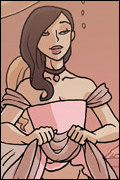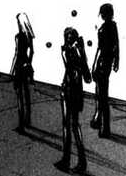|
Another thing: anyone have a backup of the offline CB? I seem to have lost my install last time I reinstalled Windows.
|
|
|
|

|
| # ? May 16, 2024 20:05 |
|
Perhaps...
|
|
|
|
The Crotch posted:Perhaps... Thanks!
|
|
|
|
If I'd want a sneaky ranged magey type, what would my choices be?
|
|
|
|
That is exactly the warlock. Skirmishy types who get free concealment for moving around.
|
|
|
|
Which pact would you recommend? Infernal looks kinda hilarious if you could find a reliable way to damage yourself for low damage.
|
|
|
|
If you're looking to go hardest on "sneaky and ranged", fey works best with its emphasis on teleportation and invisibility. Vestige is also good there for its easy access to prime shot, something that you often won't get otherwise if you're trying to hang back. I'm a big fan of infernal, which is generally more of a close-range skirmisher, and can be done with either a charisma or con focus. If you're in to teleport optimization (and warlocks are pretty absurd teleporters), then eladrin are a bit better than other races.
|
|
|
|
So I'm going to be running a 4e one shot this Monday, specifically a loose adaptation of the old Dragon Magazine module: "The Andurian Job" , which is a bank heist. I was planning on using the invisible Stalker as a puzzle boss fight, where it is almost impossible to hit (being invisible) unless they use a different security feature from the bank (magic in that sprays when you open money without disarming it) or some other form of environmental trick to actually make it visible, at which point I plan on having it use the stats of a Dimensional Marauder except using MM3 math for a level 3 solo, and giving it 2 more initiative tracks (there would be more, except I want bank security to be an excuse for my other favourite boss gimmick: respawning minions) I will have to adjust as I'm expecting anywhere from 3-7 players (using pregens so I'm garunteed a minimum level of efficiency) however, how does this sound? Should I tweak abilities or numbers further?
|
|
|
|
If there's only 3 or 4 of them, three initiative tracks might be a bit too much? Renders any action denial rather underwhelming. With more, they probably have more tools in their collective kit to mitigate it properly, but at less than 5, maybe just 2 tracks?
|
|
|
|
That was my thoughts. I'm expecting more, but willing to adjust. 2 tracks if under 5 seems reasonable to me. I'll also lower the amount of guards that spawn per turn (3/2 turns vs 3/1 turn) as well. I was thinking that whatever method they use to reveal the Stalker would be a minor action as well. I'm not as versed with gimmick boss fights but I'm assuming this would be good?
|
|
|
|
The "safest" way to enable gimmick in fights is to create your own separate "gimmick action" track, so that it never becomes an action economy problem. (this also applies to non-standard items that you hand-out as an GM, so that it's never competing with everything else, ensuring their use)
|
|
|
|
So you wouldn't recommend adding it as another resource to be managed? That was my understanding of that kind of gimmick, figuring out who should use their minor (since you wouldn't have the stalker cleaning himself off except maybe as an end of round type deal, MAYBE.) having not run any other gimmick fights, are you suggesting this is not the case?
|
|
|
|
Moriatti posted:So you wouldn't recommend adding it as another resource to be managed? That was my understanding of that kind of gimmick, figuring out who should use their minor (since you wouldn't have the stalker cleaning himself off except maybe as an end of round type deal, MAYBE.) My view is to err on the side of usability - if they NEED to engage with the gimmick to hit the Stalker, then it doesn't much matter what action you attach it to. If they don't, then you have to balance against attacking anyway without using the gimmick, which can be difficult to gauge.
|
|
|
|
My plan was that (barring them creating a clever option otherwise, not impossible) they would need to do this to see the Stalker, and thus attack them. I was gonna stick it with minor because Always Be Doing Damage, and also they could choose wether or not to move/minor, giving them a nice tactical array of "I want to do these 4 things but have 3 actions". But I'm willing to be told that I'm stupid and in practice this will just make the fight slow and dumb.
|
|
|
|
Might depend on the players and how open they are to weird fight gimmicks.
|
|
|
|
From what I remember of the invisibility rules, you still know which square an invisible enemy is in unless they used a Stealth action, and there's no concealment penalty to your blasts and bursts to hit invisible enemies. If you're playing by the book you'll want to take that into account, and it may simplify whatever gimmick you decide to introduce.
|
|
|
|
Looking into it, it seems you are correct. This works in line with the gimmick as I'm cool with AoEs being shot in that things direction. Another solution I hope gets utilised is the brawler grabs the Stalker. And if this fight fizzles, I have a reskinned Young White Dragon in my back pocket.
|
|
|
|
Reskinned dragons really make for the best solos.
|
|
|
|
Yeah, though I've a 3.5 hour window, so I'll have 3 planned encounters, I only expect to use 1-2 of them though. It's more if the Stalker goes over like a wet fart I have one of the two reskin possibilities suplex it into oblivion. It'll be most of their first times playing 4e, and at least one's first time playing D&D (The reason I''m doing this, he wants to see the game played before GMing for his friends.0
|
|
|
|
Playing a storm invoker, we're climbing a slippery rope up, me rolling shittily all the way up, blocking the people behind me. I get to one square before the top, say gently caress it, and zap myself with divine bolts for the 1 square shift 
|
|
|
|
Hey, I gots a rules question: If you meet the triggering requirements, can you use an immediate action during a surprise round, assuming you're capable of acting on a surprise round? For example, an ally using a ranged attack during a surprise round, and a Battlefield Archer using Combined Fire as an immediate reaction. If you're able to act when YOU'RE surprised for some reason, can you use an immediate then? I'm leaning towards no, since you're able to use a standard, move or minor action, but I just realized I've never been in a situation where that may come up. Gharbad the Weak fucked around with this message at 20:20 on Sep 13, 2017 |
|
|
|
The RC specifically calls out immediate actions as a thing you can do in the surprise round if you're not surprised, but only when it's not your turn. It's page 191.
|
|
|
|
Hey, so I'm considering bringing the Escalation die from 13th age over to 4e. Would it just simply work as - is, or should I modify it in any way before starting to give monsters/PCs things that interact with it? I seem to remember someone once saying that you should count everyone as -1 at round 1, normal at round 2, and then +1 at round 3 but I not sure.
|
|
|
|
Lemon-Lime posted:The RC specifically calls out immediate actions as a thing you can do in the surprise round if you're not surprised, but only when it's not your turn. It's page 191. Thanks. One more thing: The Warmaster Tactical Awareness feature allows someone to act during a surprise round "even while surprised." So, even though you are able to act, you're still surprised, and so that creature would not be able to take an immediate action, correct? Or does "Can act during a surprise round" overrule that? Spiteski posted:Hey, so I'm considering bringing the Escalation die from 13th age over to 4e. Would it just simply work as - is, or should I modify it in any way before starting to give monsters/PCs things that interact with it? I think the easier way would be just to add one to all monster defenses. Gharbad the Weak fucked around with this message at 22:10 on Sep 13, 2017 |
|
|
|
Gharbad the Weak posted:The Warmaster Tactical Awareness feature allows someone to act during a surprise round "even while surprised." So, even though you are able to act, you're still surprised, and so that creature would not be able to take an immediate action, correct? This one is up to GM interpretation but I would argue that Tactical Awareness lets you do everything you would be able to do if you weren't surprised, even if you're surprised. There's no reason why it would apply to one part of the list of things you can do on a surprise round when not surprised but not to the rest. Without Tactical Awareness: Surprising: 1 standard action OR 1 move action OR 1 minor action; AND free actions AND opportunity actions AND 1 immediate action (but not on your turn). Surprised: nothing at all. With Tactical Awareness: Surprising: 1 standard action AND 1 move action AND 1 minor action. Nothing else! Surprised: 1 standard action OR 1 move action OR 1 minor action; AND free actions AND opportunity actions AND 1 immediate action (but not on your turn). RAW, Surprising + Tactical Awareness means you lose free actions, OAs and your immediate action, but that's dumb and it should just give you a normal full turn when not surprised during a surprise round.
|
|
|
|
Spiteski posted:Hey, so I'm considering bringing the Escalation die from 13th age over to 4e. Would it just simply work as - is, or should I modify it in any way before starting to give monsters/PCs things that interact with it?
|
|
|
|
Lemon-Lime posted:Tactical Awareness: Thanks for the writeup. I'll point my DM to this and let him make his decision.
|
|
|
|
Cheers, I'll adjust the enemy defences by 1 and see how that goes. Thanks both of you
|
|
|
|
Yeah the "official" implementation is to increase all defenses by 1 to compensate, but I've also done it just implementing Escalation Dice with no other changes and it worked out fine.
|
|
|
|
tldr: I've been editing 4e for a while based on popular ideas like DTAS and gradenko's bonus chart and other stuff that's been talked about here for years gradenko's scaling chart is in the vein of a rewrite of 4e that I've been working on, that hedges much closer to the original text than Strike!. My design goal is to emphasize the tactical game present in 4e and reduce the lingering presence of simulation cruft. Strike! is maybe the best example of where this type of design should be headed, and what I've done is bordering on "not 4e" from a purist perspective. My reason for doing this is that it's where my house rules were headed. I got to the point where editing the entire game from the ground up made sense. I use +level as the central modifier for attack rolls, skills, and initiative. After digging into the math a bit, I came to the same conclusion as others here have, that the original spread of bonuses were around 4/5ths of the character's level, or getting very close to just +level or better with charop. Following from the First Level Damage idea, I figured out the average number of attacks needed for a typical 1st level fighter to kill a level 1 goblin, along with other similar situations, then extrapolated from that and ended up with my simpler set of modifiers and defense scores. I spent a while figuring out probable encounter lengths in terms of rounds and actions, then tweaked my numbers so that combat length tends to be around 3 or 4 rounds of idealized and averaged actions. For defense scores I tried a few different ways of determining a sweet spot and eventually settled on a base 9 +level +modifier for PCs, and base 7 +level +modifier for monsters. I thoroughly rewrote damage and hit points too. Damage is always Xd6 +modifier. The modifier to damage is where I kept something resembling ability score bonuses. Instead of distinct ability scores I'm using a system of three bonuses, which I've titled Primary, Secondary, and Perk. Primary starts at the +5 we're used to from charop ability score 20 at 1st level, Secondary is a +3, and Perk is a +2. Primary and Secondary scale at +1 at levels 5, 10, 15, etc., and Perk scales at +1 at levels 10, 20, 30. For the corresponding change in HP, I'm using base 20 +1/level, with defenders getting +Primary on top of that. The KPR is set around mid charop levels, which helps keep combat from dragging out. Most of the powers in 4e expect your character to have a one good stat for the attack roll and damage, and then a more modest stat for a rider. That expectation corresponds to what I called Primary and Perk. Secondary is for situations where I needed a number between those, either an upgrade from Perk or a downgrade from Primary, which is something we see in things like secondary attacks. I got rid of all the weapon and armor details in favor of fewer categories and types. The proficiency bonus and damage die of weapons in 4e is somewhat a sim holdover from 3.x, where each weapon is modeled according to D&D's weird idea of what weapons are and how they work. I don't need the proficiency bonus, and consequently there's also no reason to have different damage dice. I changed the weapons over to broad categories, so "Heavy Blade" is its own thing for the purpose of the rules, and you can color that however you like, as a longsword or tulwar or whatever. Class features, powers, and feats are where the main distinctions between most weapon categories become apparent. Armor is far more generalized. AC in the original text tends to end up around only a few points of difference at each extreme (lightest to heaviest), so I swapped all of that out for a class bonus from +1 to +3, e.g. Wizards get +1 to AC, Warlords get +2 to AC, and Fighters get +3 to AC. There are still class features that can offer different build options for AC. Since class determines AC bonus, armor is also more easily colored however you like. Plate armor vs. a display of big muscles is more clearly an aesthetic choice instead of a simulation. For skills I just let PCs take training in any 5 at 1st level, and they get one more at level 11 and 21. PCs can choose one of their trained skills as a focus, instead of needing a feat. Training still gives a +5 bonus and focus gives a further +3. The skill DC chart is changed to 8/13/16 for easy/medium/hard, and level is added to that (e.g. a hard DC for a level 26 character is 42). All of the other +X bonuses to skills have been removed, so the bonuses and DCs maintain predictable scaling as levels go up. I got rid of all magic items. The necessary magic items that make classes or certain builds work are things that I'm reincorporating as class features. The +s from items are now incorporated directly into the simpler scaling and are unnecessary; this is like a step further in the line of thinking that Inherent Bonuses came from. Magic items can still exist but are optional, and their main function is to offer an extra power instead of fixing math or fixing a class. There are other deeper design problems I've tried to address too, like I've removed the -2 penalty to attack rolls from being marked and created a new "distracted" condition that all controller classes have as a feature. "Distracted" is where the vector -2 attack roll penalty lives now. This creates a tension between risking punishment from a defender while taking no numerical penalty for attacking the squishy distracting controller, or attacking the defender but suffering a penalty to the attack roll. This is the most radical change I've made to the gameplay, but I've found in testing that it produces more interesting dilemmas than what I was used to seeing in 4e, and there's less certainty involved than the Opportunity damage in Strike!. Attack penalties are another design problem. There are many ways to stack those in 4e, to the point where they offer a functional stun at low levels. In charop, this produces a hunt for any game effect that can give a penalty, much like the hunt for any possible + to an attack roll. That's the kind of thing I want to eliminate, because it rewards a form of system mastery that tends to reduce challenge instead of making challenge interesting. To limit attack penalties, I introduced a condition I titled "Disrupted," which accounts for many of the game effects that previously granted an untyped penalty to an attack roll. The milestone pacing that 4e, 13th Age, and 5e (sorta) use is emphasized heavily in my rewrite, so Daily powers are now Milestone powers. I've used a house rule for milestones and recharging powers in my normal 4e games which has worked well for me, so I adopted that into my rewrite. Rituals are likewise now siloed into a separate subsystem where characters receive points to spend just on that, and they're gained at the same time you gain APs. Both APs and ritual points are "use 'em or lose 'em," where you can only ever have 1 AP at a time, and your ritual points reset at level up, so there's more of an incentive to use these points instead of stockpiling them and never using them. I've also been slowly and carefully going through all of the classes, editing the features and powers to clarify, balance (mostly upgrades to seldom-used powers), and expand them, while cutting out the worst. The old WotC charop board has been of enormous help for that. The bulk of my work has been on editing powers. I haven't removed feats entirely but I've edited or removed many of them so the total list is more manageable, though not as spartan as 5e. All of the tax feats are edited or removed. For example, the weapon expertise feats only have a small functional benefit to their respective category of weapon, and don't have the tier scaling bonus to attack rolls. Ability score requirements are out, and prerequisites are limited to level, class, and class feature. The math for the Healing Word leader powers also tended toward healing a character's bloodied value after all the feats and other small bonuses were accounted for, so I removed all of those +X things and now the Word powers let you regain your bloodied value at the cost of a healing surge (this is also what Strike! does). Of course, I can't publish most of this because it would be a derivative work, and I would never violate a copyright. fog boar fucked around with this message at 05:13 on Sep 14, 2017 |
|
|
|
I had an argument with a friend yesterday about whether or not Themes break the game. I said they don't, as I've never heard of it before, while he claims that by giving a bonus they become mandatory in order to not be underpowered OR they make everyone too powerful. Anything I could say to disprove his claims? Or is he right?
|
|
|
|
I'd never run the game with only some people using themes, but if everyone takes them, it's no issue. I wouldn't call them particularly well balanced against each-other, but they're not going to raise the power level so greatly that you can't easily compensate.
|
|
|
|
Themes (and backgrounds) are a free power increase with no costs so yes, if you include them in the game there's zero reason not to pick one. As long as everyone has them and the GM takes that into account while designing encounters, I wouldn't call them broken. And yeah, they're balanced very poorly against each other. Lemon-Lime fucked around with this message at 12:43 on Sep 14, 2017 |
|
|
|
Also I'm pretty sure in the setting that introduced them you were pretty much explicitly expected to take one.
|
|
|
|
MonsieurChoc posted:I had an argument with a friend yesterday about whether or not Themes break the game. I said they don't, as I've never heard of it before, while he claims that by giving a bonus they become mandatory in order to not be underpowered OR they make everyone too powerful. The thing is, Themes give you an extra bonus and/or power at level 1. Even though all the later powers are utility ones that only broaden your options, the level 1 bonuses give you an edge over someone who doesn't have a Theme. Maybe it's on the same of "+1 damage when flanking", but it's still something. Your friend is technically correct as far as everyone or no-one should have Themes.
|
|
|
|
unseenlibrarian posted:Also I'm pretty sure in the setting that introduced them you were pretty much explicitly expected to take one. From what I recall, all the themes introduced with Dark Sun were just new power choices sorta like Skill Powers. Sometimes worth taking but it's at the cost of the regular class choice for the level. Later themes were basically flat upgrades though, yeah.
|
|
|
|
isndl posted:From what I recall, all the themes introduced with Dark Sun were just new power choices sorta like Skill Powers. Sometimes worth taking but it's at the cost of the regular class choice for the level. They got more powerful as they switched from power swaps to always-on abilities (and then to both, in some cases), but even then they are far from game-breaking. (But yeah, everyone should have them or nobody should have them.)
|
|
|
|
Without themes, I wouldn't have been able to play the wererat hengeyokai Mr. Scabies, who was half-ratman and his other half was also half-ratman.
|
|
|
|
gradenko_2000 posted:The thing is, Themes give you an extra bonus and/or power at level 1. Even though all the later powers are utility ones that only broaden your options, the level 1 bonuses give you an edge over someone who doesn't have a Theme. Maybe it's on the same of "+1 damage when flanking", but it's still something. The big thing was mostly regarding encounter maths being off, as stronger PCs changes stuff. We probably won't be using theme in our upcoming game of Planescape (we were making characters, which started the whole thing) but it got me thinking anyway.
|
|
|
|

|
| # ? May 16, 2024 20:05 |
|
From my experience, themes don't really change the encounter math significantly, since they tend to be an added encounter power. The only one I can think of off-hand that does is "Masked Lord" but it's also a cool transformation power so....
|
|
|


















